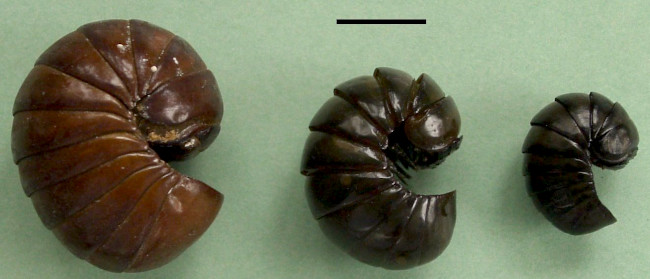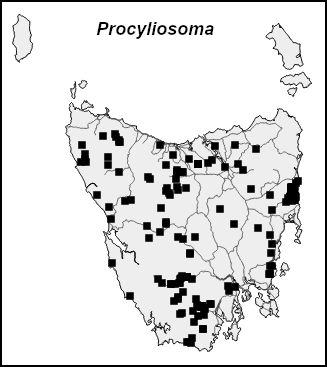Sphaerotheriida

At first glance, sphaerotheriidan "pill millipedes" resemble the introduced "pillbug" slater Armadillidium vulgare, which is an isopod crustacean. Pillbugs and pill millipedes are both capable of rolling up tightly into a ball to defend themselves. Tasmanian sphaerotheriidans are in family Procyliosomatidae, genus Procyliosoma. Although Procyliosoma leae Silvestri, 1917 and P. tasmanicum Silvestri, 1917 were both described from Tasmania, neither species can be easily recognised among the many specimens in collections. A third, undescribed species (pictured below, centre) is our largest pill millipede. It has a very restricted range on the East Coast but is well-conserved in the Douglas-Apsley National Park, where it is abundant.

Pill millipedes from Lamington National Park in Queensland (left), the East Coast south of St Marys (centre) and the Arve valley forest west of Geeveston (right). Scale bar = 10 mm.
A start has been made in sorting out our species by pill millipede expert Thomas Wesener, who has identified specimens from Lake Paloona (near Forth in the northwest) as P. leae. According to Silvestri (1917), this species was collected by Arthur Lea at or near Hobart. However, another Silvestri species collected by Lea, the polydesmidan Asphalidesmus leae, was also said by Silvestri to be from Hobart, yet A. leae is only found in northern Tasmania. It may be that the pill millipede P. leae is likewise a strictly northern Tasmanian species.
Pill millipedes are active at night in wet forest and can be seen wandering around (and climbing trees!) beginning about an hour after sunset. During the daytime they prefer sheltering in small groups in richly organic humus, as can be found under stones in dolerite talus and on the floor of long-unburned forest. Procyliosoma populations recover quickly from fire, and pill millipedes can be abundant in silvicultural regrowth 10+ years old.
Procyliosoma spp. localities are shown below. No pill millipedes have so far been found on the Bass Strait islands. There are also many apparently suitable forest sites where Procyliosoma have not been collected: the genus distribution is "patchy" in Tasmania.

